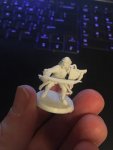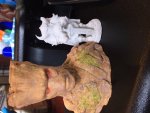[MENTION=151]WizarDru[/MENTION]
Thank you for the thorough reply. I greatly appreciate getting some information from someone who owns a 3d printer and has specifically used it to try to print 28MM scale minis. Also, I would very much like to see some of your results.
I confess I didn't expect a low price range 3d printer to be great for printing minis. That said, I can manage something in the $1,000 U.S. price range, provided it's a one-time capital investment that will last me at least 5 years.
The funny thing here is that price isn't
quite the determiner of print quality that you might think, at least not for FDM printers. At their heart, they are incredibly stupid machines: just a set of stepper motors, a heating element, some rails and some control hardware. That's a large reason that they CAN be that inexpensive. Another reason is that the hardware is pretty standardized AND the control software used by most printers is open-source (a version of Arduino's firmware). Because of those facts, a company like Monoprice, CReality and others can manufacture relatively decent units on the cheap. And because they are open-source, the community supports software that works on most machines (though not universally so). HOWEVER, spending more on a printer gets you both better features, better equipment and actual support, not to mention reliability. A company like market leader/innovator Prusa Research can develop a printer like the Mk 3, which has all sorts of features (filament detection, job pausing, advanced print bed, auto-leveling, quiet mode and more) that an inexpensive printer won't. I purchased the Robo3D R1+ because I was frustrated with the relatively small print bed (and thus print size) and general fidgetiness of my Printrbot. In honesty, the Printrbot has been out of commision for months after a difficult attempt at a hardware upgrade and it's been too much effort to fix it (though eventually I'll get to it).
Now let's talk about the challenges of printing. There are several challenges with printing using FDM. One issue is, as I mentioned, the necessity for support material. When you sculpt something and create a mold, you can afford details like outstretched arms, wings, long necks, pointing swords or whatever...things that stick out from the mini over empty space. They can do this because you're essentially pouring a liquid into a glass (of course you also get mold lines, but that's another story). 3D printing works by stacking layer upon layer to make a composite image (
if you've ever seen the anime/manga Gantz, the visually disturbing way that they teleport is essentially 3D printing them). To work around this limit, software creates supports...think of them as scaffolding for the parts of your print that have gaps beneath them. Supports are designed to give your print something to start a layer on, but then be removed. This works well for difficult prints...but it becomes much more complicated at 28MM scale, where the supports tightly intertwined with the print and hard to remove (and possibly as big as the print itself). Removing that material will also leave with you a surface that will need cleaning like a traditional mini, possibly involving sanding and other methods.
The smaller scale of a mini means that you're not going to see the same level of detail that you might see from a traditional mini sculpt. To compare a highly-detailed bones sculpt with a 3D print will often be unfavorable to the 3D printed one. Part of this is due to the nozzle size: an FDM printer is basically a hose. Plastic filament is fed directly through to the 'hot-end' which is exactly like what it sounds: a metal tube that melts the filament to a liquid. The stepper motor feeds the filament into the hot-end at a careful regulated speed, which pushes the liquid plastic out the nozzle, which by default is .4 mm in diameter. This is the reason you are limited (usually) to 100mm for a layer. A resin printer can go down to 25mm...so it can create a much more detailed print. FDM printers do support additional nozzles which allow you to go down to that size, but we encounter a different problem there: speed. A 3D printer needs to go much slower with a smaller nozzle, because the smaller hole means it can force less plastic through it in the same amount of time. So the higher detailed print goes up dramatically in terms of time.
I'm going on about all of this only to give you an idea of the challenges that you can face. I LOVE 3D printing and think it is AMAZING. There is a big community of gamers making game stuff in 3D printing, from bespoke board game accessories to minis, 3D terrain and all sorts of accessories. You can do a lot. But it is not always easy. There are moments when you want to throw it out a window. And then you figure it out or fix it and life is good. But it's not a turnkey solution.
So here are two examples of mini prints from Hero Forge I've done, provided to me by people at my game meetups:


The character in white took three prints to get right. His coat and sword required extensive support material, which is why he looks so rough around the edges. Some sanding will be required to make him look 'table-ready'. This paladin (sorry for the black filament) took 5 prints to get around this level (I later figured a way to make him look better, but don't have a pic handy). He has Assimar wings, which were a challenge due to the support material ripping off his wings when removed and his hammer over his head often turned into a gloppy melted mess. I did better.
So as you can see, you can do them; you just need to expect that unless the mini was designed well or with 3D printing in mind, it may need a lot of work to get a successful print. With some paint, flocking and TLC, you can produce some really nice output:
















